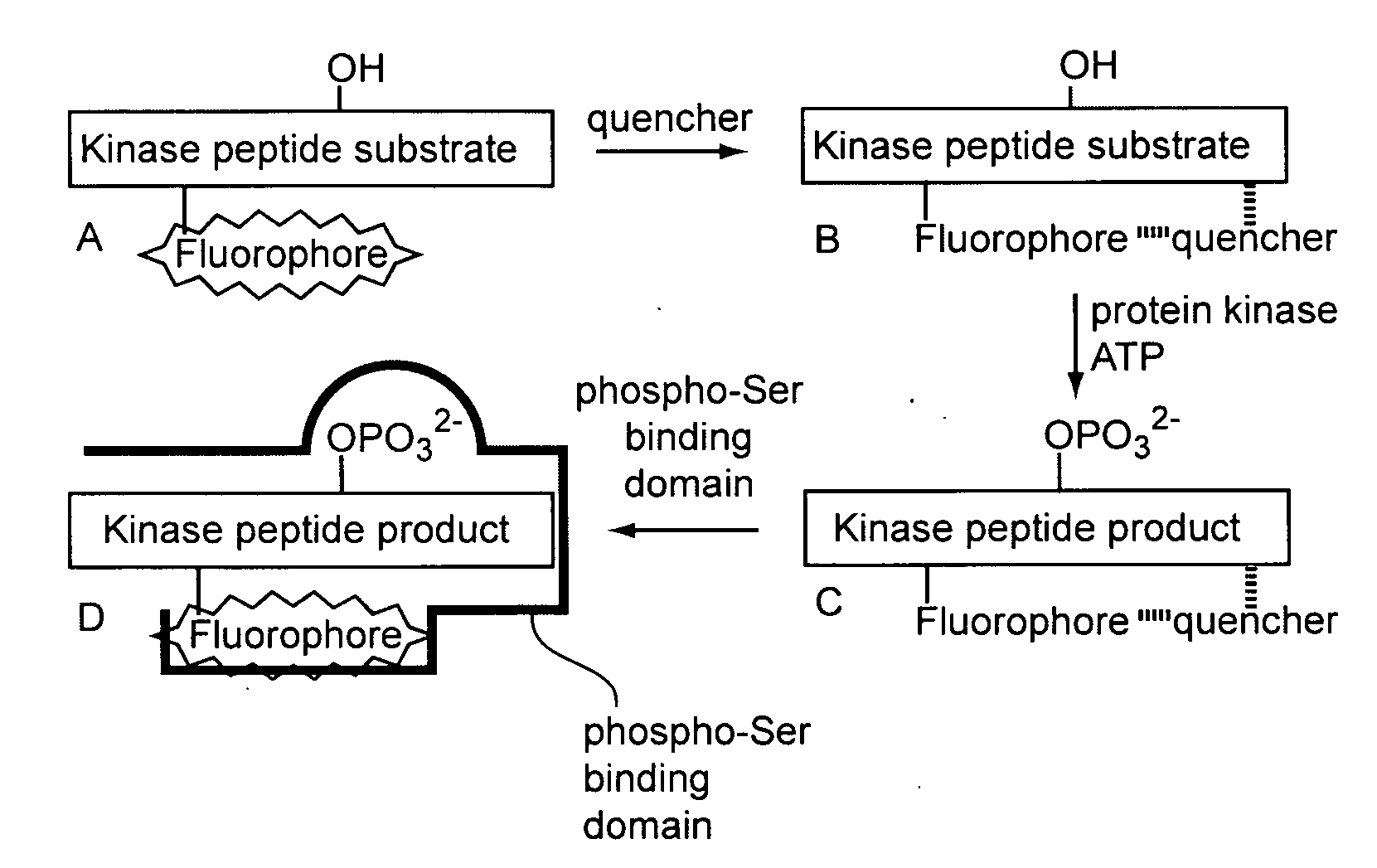Deeply quenched enzyme sensors
a sensor and enzyme technology, applied in the field of deep quenching enzyme sensors, can solve the problems of unfavorable electrostatic interaction between the quencher and the side chain, unfavorable electrostatic interaction between the side chain and the residues, etc., and achieve the effect of removing a favorable electrostatic interaction
- Summary
- Abstract
- Description
- Claims
- Application Information
AI Technical Summary
Benefits of technology
Problems solved by technology
Method used
Image
Examples
example 1
Deep Quench: An Expanded Dynamic Range for Protein Kinase Sensors
[0214]The following sets forth a series of experiments that demonstrate synthesis and use of exemplary sensors, including exemplary kinase sensors that include a fluorescently labeled substrate module, a quencher, and a detection module.
[0215]Protein kinases catalyze the phosphorylation of serine, threonine, and tyrosine residues in protein and peptide substrates. These enzymes have received considerable attention due to the relationship between aberrant kinase activity and an assortment of human afflictions. Specific and highly sensitive protein kinase sensors furnish, e.g., a means to rapidly identify inhibitors, assess protein structure / function relationships, and correlate kinase activity with cellular behavior. A large number of kinase assays have been described; however, assays with fluorescent readouts are most easily applied to both in vitro and intracellular settings. GFP-labeled protein and fluorophore-labele...
example 2
Enzyme Sensors with Covalently Attached Quenchers
[0245]The following sets forth a series of experiments that demonstrate synthesis and use of exemplary sensors. The exemplary sensors include kinase sensors that have a substrate module with a fluorophore and quencher and a detection module, as well as kinase sensors that have a substrate with a fluorophore and quencher and that do not require detection modules.
[0246]Pyrene-substituted peptides P13 (FIG. 15 Panel A, SEQ ID NO:21) and P14 (FIG. 15 Panel B, SEQ ID NO:22) were synthesized. Upon phosphorylation by PKA, P13 displays a 1.5-2.3 fold increase in fluorescence in the presence of 14-3-3%, and P14 displays a 2.2 fold increase in the presence of 14-3-3%. No significant change in fluorescence is observed in the absence of 14-3-3%. The assay was performed with a total volume of 200 μL and was initiated with the addition of PKA enzyme. The final concentrations of the reaction components are: 1 mM ATP, 1.5 mM MgCl2, 2.1 μM 14-3-3τ, 2....
PUM
| Property | Measurement | Unit |
|---|---|---|
| molecular weight | aaaaa | aaaaa |
| molecular weight | aaaaa | aaaaa |
| apparent dissociation constant | aaaaa | aaaaa |
Abstract
Description
Claims
Application Information
 Login to View More
Login to View More - R&D
- Intellectual Property
- Life Sciences
- Materials
- Tech Scout
- Unparalleled Data Quality
- Higher Quality Content
- 60% Fewer Hallucinations
Browse by: Latest US Patents, China's latest patents, Technical Efficacy Thesaurus, Application Domain, Technology Topic, Popular Technical Reports.
© 2025 PatSnap. All rights reserved.Legal|Privacy policy|Modern Slavery Act Transparency Statement|Sitemap|About US| Contact US: help@patsnap.com



